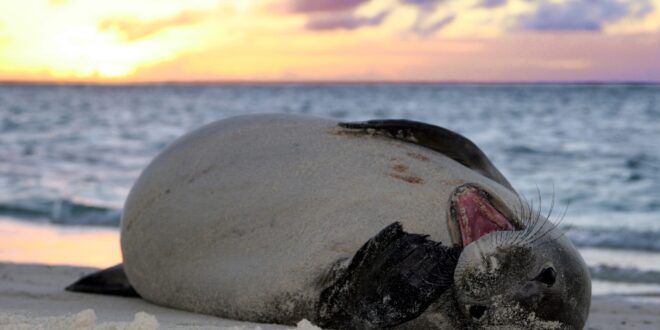By Suri Zheng
In the Northwestern Hawaiian Islands, a species of seal called the Hawaiian monk seal exists. This is the only species of seal native to and is only found in Hawaii. Apart from only living in Hawaii, they are also critically endangered and described as “One of the most endangered species in the world…The most endangered seal species in the world” (NOAA).
They are so endangered that it is illegal to touch or get close to them as they are considered “guardians over the human soul after death” and are deeply respected in Hawaiian mythology. Hawaiian monk seals can live up to 30 years and spend most of their time on beaches to conserve energy and raise pups, Occasionally they go out to sea to forage for food and find algae to grow on their fur. Newborn seal pups have a black coat, but it gets lighter as they get older. Once per year, they shed the outermost layer of their skin, and grow a more silvery coat.
Less than 1,600 of these particular seal species exist today in Hawaii, or around the world. The main cause? Food limitation, predation, hunting, fishing, plastic, etc.
Food limitation
Food is a crucial factor in growth, especially among young seals. A Hawaiian monk seal is considered a generalist meaning its diet consists of a lot of things: many types of fishes, squids, octopuses, eels, lobsters, shrimps, and crabs. Although these seals seem like tertiary consumers by how much they eat, it’s not uncommon for them to compete with other animals to hunt for food.
Predation and hunting
Although these seals would seem like they are at the top of the food chain, there are still some animals that eat Hawaiian monk seals. These animals mainly prey on the vulnerable seals, for example, seal pups. The animals that eat seals are certain types of sharks like the tiger shark or reef sharks and also large carangids, a specific type of fish.
Fishing and plastic
Plastic from fishing can cause great harm to these seals for example the fish hooks or nets from nearby fisheries. In the 1990s fishing management in Hawaii eliminated interactions between these seals. Still, it doesn’t mean plastic waste cannot be drifted out into the ocean and get consumed by Hawaiian monk seals, and therefore, cause the death of them.
Luckily, there has been a lot of action in supporting and protecting Hawaiian monk seals. Actions such as designing and protecting these seals’ habitat, reducing human-seal interactions, vaccinating seals from viruses, surveilling them for abnormalities, and many more.
 Tempus Magazine By Students, For Students
Tempus Magazine By Students, For Students 



